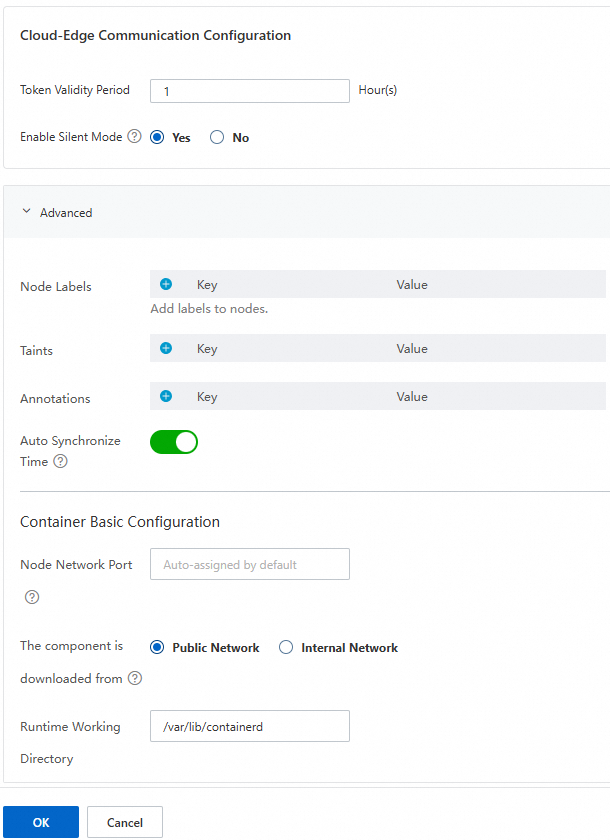Parameter | Parameter description | Description |
quiet
| Specifies whether to enable silent mode. During the node access process, some steps may require your intervention to make a judgment, such as whether to reinstall the runtime that already exists on the node. | true: The default value. All questions are automatically answered with yes to automatically advance the process.
false: During the node access process, the process may be paused to obtain your confirmation, and the node access process may be interrupted.
|
manageRuntime
| Specifies whether edgeadm detects and installs the runtime. | |
nodeNameOverride
| The name of the node. | "": The default value. Uses the hostname.
"XXX": Specifies the node name as XXX.
"*": Randomly generates a 6-character string.
"*.XXX": Randomly generates a 6-character string with the XXX suffix.
|
allowedClusterAddons
| The list of components to be installed. For a regular node, set this parameter to ["kube-proxy","flannel","coredns"]. | ["kube-proxy","flannel","coredns"]: The default value.
|
gpuVersion
| Specifies whether the node to be added is a GPU-accelerated node. By default, this parameter is empty. For the supported GPU versions, see GPU models. | "": The default value. The node is not added as a GPU node.
Starting from version 1.26 of ACK Edge clusters, when adding an Nvidia GPU, you do not need to configure the gpuVersion parameter. The access tool automatically checks the GPU model and installs the relevant components. |
labels
| Specifies the labels to be added to the node. Node pools support adding labels to all nodes in the node pool. If the label conflicts with the label key on the node pool, the label defined on the node pool has a higher priority. | {}: Does not add any labels.
|
annotations
| Specifies the annotations to be added to the node configurations. If the annotations conflicts with the annotations on the node pool, the annotations defined on the node pool has a higher priority. | {}: Does not add any annotations.
|
taints
| Specifies the taints to be added to the node. | []
|
nodeIface
| Specifies the host network interface card. This parameter has two functions: | "": If set to empty, kubelet will obtain the node IP in the following order.
flannel will use the network interface card in the default route of the node. |
runtimeRootDir
| Specifies the working directory of the runtime. This configuration takes effect only when manageRuntime is set to true. | "": The default value.
When the runtime is Docker, the default path is /var/lib/docker. When the runtime is Containerd, the default path is /var/lib/containerd.
|
imageRepoType
| Specifies the source of system component images on the node. | "": The default value. Nodes in a leased line node pool download images from the internal network, and nodes in a regular node pool download images from the public network.
public: Downloads images from the public network.
private: Downloads images from the internal network (the node is connected to a leased line node pool).
|
selfHostNtpServer
| Specifies whether to manually synchronize the time. | |
flannelIface
| The network interface card name used by flannel (not recommended, you can use the nodeIface parameter instead). | "": The default value. flannel uses the network interface card used by the default route of the node.
|
enableIptables
| Specifies whether edgehub enables iptables optimization (not recommended, deprecated after version 1.22). | false: Does not enable iptables.
|
 Elastic Compute Service (ECS)
Elastic Compute Service (ECS)
 Lingma
Lingma




 > Add Existing Node > Add Existing Node in the column.
> Add Existing Node > Add Existing Node in the column.
























